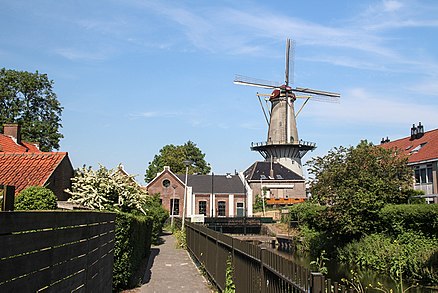Spijkenisse - town and former municipality in South Holland, the Netherlands

Spijkenisse is a city on Putten, one of the islands of South Holland. Spijkenisse is the third city in Greater Rotterdam. After merging with the neighbouring municipality of Bernisse, the newly formed Nissewaard is the second-most populated municipality of Greater Rotterdam.
Understand
The area around Spijkenisse has been settled for some good time, with traces being found of hunters and fishermen that have lived in the Meuse estuary since 10,000 BC. Spijkenisse itself grew as a community of farmers and fishermen along a creek of the Old Meuse (Dutch: Oude Maas). The north bank of the creek became a dike witch housing alongside it. This dike is nowadays the Voorstraat. The houses, meadows and a stone church around the Voorstraat became the city centre. The town, being located in the Meuse estuary and the river delta of the Netherlands, was occasionally flooded, most frequently in the 16th century. During the following two centuries, Spijkenisse would be stuck by several fires, which all limited the growth of the town.
After the Second World War, Spijkenisse was still a rather small town with some 2,500 citizens, but in the 1960s and 70s, there was a great influx of inhabitants, growing the municipality to an average size. Spijkenisse to this day is trying to shrug off the title of groeikern (growing centre), doing so by creating a larger and more diverse city centre.
Get in
By car
From Zeeland, follow the N57 up north, only leaving the N57 once the exit for Brielle can be found by the side of the road. Take this exit, turning right at the end of the exitramp. Follow the road you're on now, the N218. Go straight after passing the McDonald's on your left, avoiding a connection to the A15. At the roundabout you should find yourself at, go left (third exit) onto the Groene Kruisweg, turning right at the first major interchange. Go straight on this road (Hekelingseweg), which will turn into the Ruwaard van Puttenweg. At this point, you should be able to see the Spijkenisse Centrum metro station on your left hand side. This is the best point from which to explore the area.
By public transit
Rotterdam's metro network, operated by RET (dead link: December 2020), covers Spijkenisse, with lines C and D serving three stations: 📍, 📍 and 📍. All of these are served by both lines. From Rotterdam Centraal train station use line D. From Beurs metro station in the center of Rotterdam, line D is 2 minutes faster than line C.
Get around
The historical centre of Spijkenisse is easy to get around on foot, with the parts of town outside of the centre being rather uninteresting to the traveller. These parts of town, however, can be reached via buslines 81, 84 and 105. The metro system of Rotterdam reaches into town, and is a faster alternative to the buses.
See
- Museum & Groentewinkel MAK, Voorstraat 26, 51.85050°, 4.32668°, +31 181 620 746, info@groentewinkelmak.nl. Every 1st and 3rd Saturday of the month, 13:00-16:30. Museum run entirely by volunteers. The museum shows the history of Spijkenisse through the façade of a simple grocery store. 2017-11-25
- De Boekenberg, Markt 40, 51.849597°, 4.324753°, +31 181 616 622. De Boekenberg (the mountain of books) is the Spijkenisse public library, which is shaped like a pyramid or mountain, with books upon books stacked up to the ceiling. 2017-11-25
Do
Buy
Eat
- Olijf, Voorstraat 54, 51.84956°, 4.32594°, +31 181 619 066, info@etenbijolijf.nl. 2017-11-25
- Zorba de Griek, Voorstraat 43, 51.85013°, 4.32667°, +31 181 611 780. 16:00-21:30. €25.50 2017-11-25
- Il Siciliano, Voorstraat 30, 51.85033°, 4.32654°, +31 181 506 029. 2017-11-25
- 't Oudste Huys, Voorstraat 18, 51.85078°, 4.32627°, +31 181 375 283. 2017-11-25
- De Beren, Westkade 51-55, 51.85146°, 4.32807°, +31 181 611 252, SpijkenisseRestaurant@beren.nl. 2017-11-25
- Ristorante Pappagallo, Karel Doormanstraat 6, 51.84901°, 4.32308°, +31 181 610 221, info@pappagallo.nl. 2017-11-25
- Meiden van de Molen, Noordeinde 99, 51.85292°, 4.33037°, +31 181 629 011. 2017-11-25
Drink
- Gers, Voorstraat 15, 51.85094°, 4.32679°, +31 181 507 137, info@gersspijkenisse.nl. 2017-11-25
- Cardan, Voorstraat 11, 51.85112°, 4.32678°, +31 181 657 203. 2017-11-25
Sleep
- Carlton Oasis Hotel, Curieweg 1, 51.85247°, 4.30588°, +31 181 625 222, info@oasis.carlton.nl. Carlton Oasis is a luxurious hotel between Rotterdam and Zeeland. €101 2017-11-25
- Atlas Hotel, Groene Kruisweg 11, 51.85299°, 4.31993°, +31 181 659 944. €110 2017-11-25
Connect
Go next
- Spijkenisse is close enough to where the Delta Works are easy to explore in a day trip, taking a ride along the N57, which shows the feat of Dutch engineering from the closest you'll ever get to it. The N57 runs across the sluices that defend the Netherlands against the tides.
- Brielle, the first city to flip to the Dutch side in the Eighty Years War, resulting in an independent Dutch Republic, is just twelve kilometers to the west.
- Rotterdam is a great city trip, with the city's metro system reaching to Spijkenisse. The Central station can be found on line C, while the Maritime Museum, Markthal and Kubuswoningen can be found on line D, both of which terminate in Spijkenisse.
- The Hook of Holland is not only a major harbour, it also features a great beachfront, which can be reached via metro line C and D, changing at Rotterdam Beurs onto an A-line train heading for Hoek van Holland Strand.
- The Hague, the political capital of the Netherlands is connected to metro line E, an extension of line D.
Spijkenisse
spijkenisse.nlSouth Holland
Primary administrative division